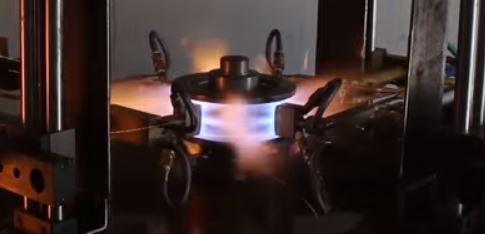The Beauty of Spin Hardening

Let’s review flame hardening equipment and design methods. All localized hardening methods (induction, flame) consist of heat and quench. In stationary flame hardening, the part and/or flame head remains in place for both heat and quench cycles. In spin hardening, the flame heads remain stationary but the part spins in front of them for heating, and drops into quench for cooling. This process lends itself well for circular parts that require an even hardness pattern around the circumference of the part. Crane wheels need the tread and the inside of the flange to be hardened, so these are ideal for spin hardening. See the video “Spinning Flame Hardening Method Video.
Spin hardening is by far the most common form of flame hardening solution we have provided over forty years in the heat treating business. Most hardening applications involve parts that are turning and grinding against metal, so their circular shapes lend themselves to spin hardening for the easiest, fastest application of case hardening.
In spin hardening, as in all flame hardening methods, the flame head must be built to match the sectional profile of the part. In the case of the crane wheel, the larger the tread (wheel height) the larger the flame head needs to be. The goal is an even depth of hardness along the tread and inside the flange.
Speed of the heat application is key to spin hardening. It needs to be done as quickly as possible, so the larger the part, the more flame heads need to surround the part. Therefore, spin hardening machine designs can range in size from one torch to as many as eight torches, each capable of supporting two flame heads. A note of clarity: at FTSI we distinguish between torches and flame heads. Flame heads distribute the flame to the part; torches mix the ratio of fuel to oxygen to be distributed to the flame head. Torches connect directly to fuel and oxygen hoses; flame heads connect to the torches.
Of course, it’s not just the heat it’s the cool. On the FTSI spinning machine, the torches are mounted above a quench tank with a chuck to hold the part. Once the part heats to the required temperature, the chuck lowers the part into the quench, which is monitored and kept at the best temperature to achieve the cooling cycle that will result in the desired hardness level. Inside the quench tank, nozzles direct the quench at the part.
If the type of steel or cast iron requires it, the quench could be straight water or some mixture of a polymer. Straight water cools the part the fastest, and polymer slows the rate of cooling. As I’ve said, if the rate of cooling is too fast for your material or the geometry of the part, you risk cracking. So we design the quench system with as much attention to those details as we do the design of the torches and flame heads.
Because it’s a closed cooling system, the quench often requires an exchange system to maintain a typical range of temperature between 80-110 F. We accomplish this by using a plate coil heat exchanger either external or internal to the tank and a chiller.
To run a spin hardening machine, an operator typically only has to load the part, hit a cycle start button, and after the part comes up out of the quench, unload the part. (If a part is over 25 pounds most clients use a crane for loading and unloading.) As I’ve already stated, since spin hardening is built for speed and is so automated, it’s one of the best flame hardening solutions for higher production quantities. It also has one of the easier setup processes so that changing over to different sized parts can be done quickly and efficiently.
Versatility, ease of use, and speed are all hallmarks of spin hardening and reasons why most clients choose this method to meet their case hardening needs. These machines cover a wide variety of parts that need heat treating, including gears, sprockets, and small shafts. In addition to heating around the circumference of a part, spin hardeners can also harden the inside diameter. We’ve seen this done on gear teeth, splines and smooth surfaces. Spin hardeners can accommodate such a large variety of sizes as well. We have set up clients who are hardening parts upwards of 50” in diameter and as small as 1” in diameter, with surface heights ranging from one to twelve inches. We love to design a complete solution that provides as much versatility to a client as possible, so that cost reductions can be realized across production lines.
Next week we’ll talk about the progressive method of flame hardening and the applications best suited for it. I’m always ready to talk to you about any heat treating question, flame hardening equipment, and particularly if you are using or considering using flame for localized hardening. Give me a call at 919-956-5208 or email mark@flametreatingsystems.com.
B17: We would like to know your opinion.






